Fashion In Art: Fleurs de Villes ARTISTE
In this iteration: Scottish heritage, brought to life with flowers
Hey Matryoshkas,
If you’re wondering where I’ve been these past few weeks, I’ve just returned from a fabulous whirlwind trip around Edinburgh – courtesy of my partner Holly, who works in events and was kind enough to bring me along for the ride. (Yes, we both have the same name.) While we were in town, we visited Fleurs de Villes: ARTISTE; a gorgeous floral exhibition that ran from the 31st May–9th June at the Royal Botanic Gardens. In elegant surrounds, I had the pleasure of speaking to Fleurs de Villes’ co-founder, Karen Marshall, who lent some insight into the conception of the project. As the exhibition is no longer running – like all flowers, its blooming season is only brief – I’ve decided to write about the experience so that I can share it with you. Consider this article a pressed flower, of sorts: a little time capsule of the beauty that was.
There’s a particular smell that hits you as you pass from the streets of Edinburgh into the Royal Botanic Gardens. The city falls away – the sound of cars is muted, the grey cobbles forgotten – and what takes its place is birdsong, the shush of wind in the trees, the sticky fragrance of flowers. My partner and I wound our way up through various segments of garden before we reached the large white marquee where Fleurs de Villes: ARTISTE had made its temporary home. Already, we were inundated with early-summer flowers, lulled into a relaxed joy pointing out bees to each other as they rummaged through the petals. So it was not only the sudden abundance of flora that makes me say that stepping into the Fleurs de Villes tent was like stepping into another world.
“Welcome to the UK premiere of Fleurs de Villes ARTISTE,” proclaimed the sign at the door; “a fresh floral celebration of Scotland’s remarkable art and the nation’s much loved artists, all created by Edinburgh’s talented florists.”
Inside, a neatly-spaced array of mannequins awaited, transformed by said florists into vivid portraits of cultural significance. The smell of flowers intensified here, but never became cloying: the marquee had an open side, which let in a steady stream of fresh air and sunlight. Providing a backdrop to it all was a gentle susurration of piano music – not too quiet, not too loud – perfectly suited to the mood.
My partner and I toured the displays, taking our time to appreciate the craftsmanship and personality which had gone into each. There was a wealth of talent on show, illustrating the depth of connection that runs between different forms of art, as the florists drew inspiration from portraiture, photography, fashion, song, dance and Scottish heritage more broadly.
My favourites were the mannequins representing Annie French and the Dovecot Weaver.
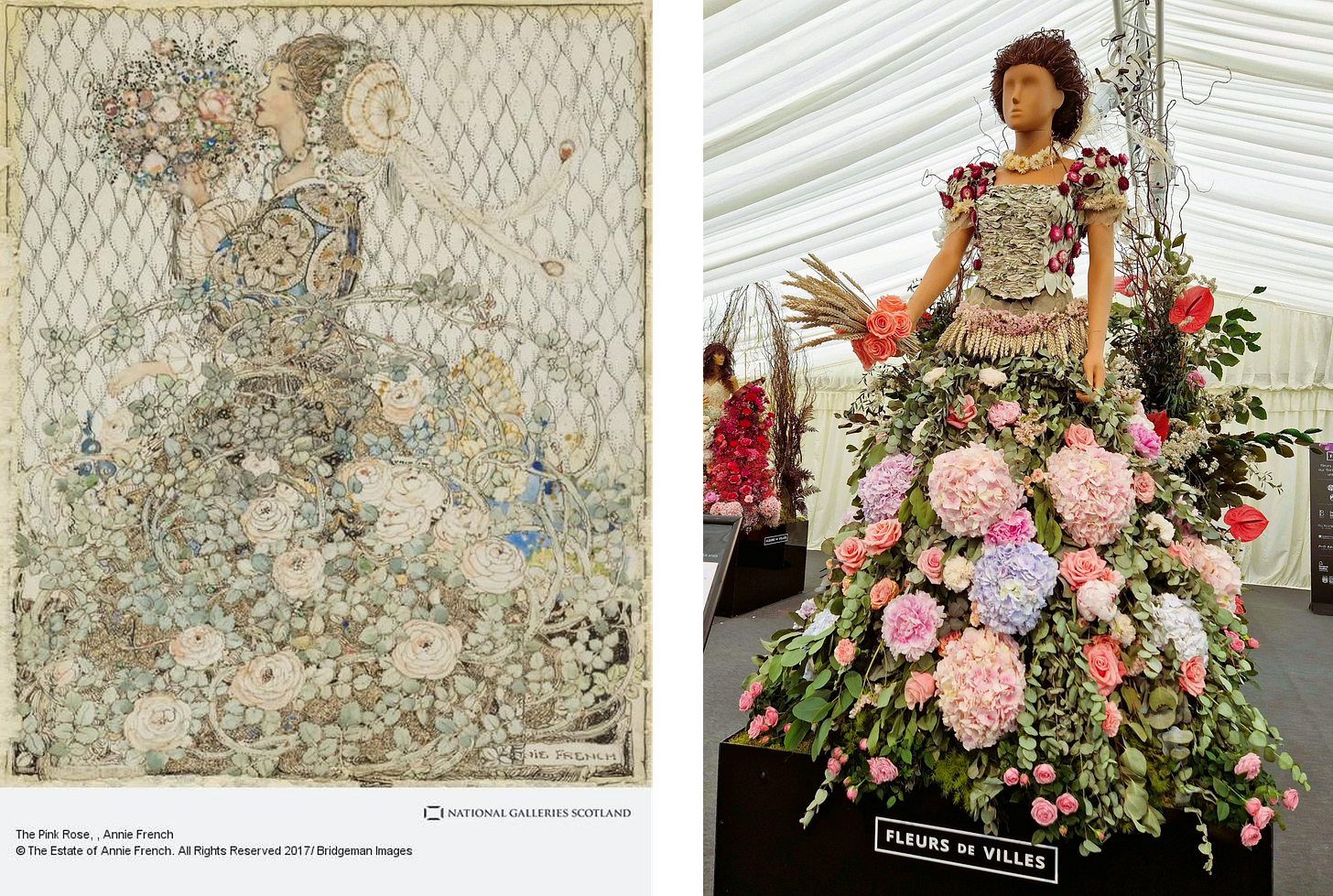
Annie French (1872-1965) was one of the Glasgow Girls: a group of artists associated with the prestigious Glasgow School of Art at the fin-de-siècle. She was best known for black-and-white illustrations in an Art Nouveau style, although the work that inspired this floral tribute – The Pink Rose – incorporates delicate colour. “This floral mannequin brings The Pink Rose to life with whimsical greenery and a mix of light and airy pink and white blooms including roses, hydrangea and carnations,” read the accompanying placard. It was created by Petals By the Shore.
This piece, celebrating Dovecot Studios, was created by Pirita Blooms, whose floristry specialises in dried and preserved blooms. A complex feat of botanical engineering, this work shines a light on traditional women’s crafts and the skill that is poured into them.
“This intricate design is inspired by the 2024 summer exhibition at Dovecot Studios that features The Caged Bird’s Song,” the accompanying placard explains. “As the Master Weaver diligently works on her floral weaving that is displayed on the botanical loom, the natural elements of the tapestry seem to come alive beside her.”
I could talk endlessly about each individual installation, but I think they speak for themselves:
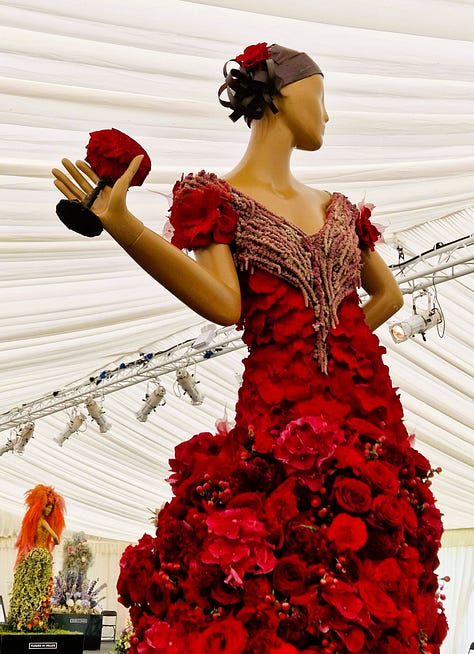
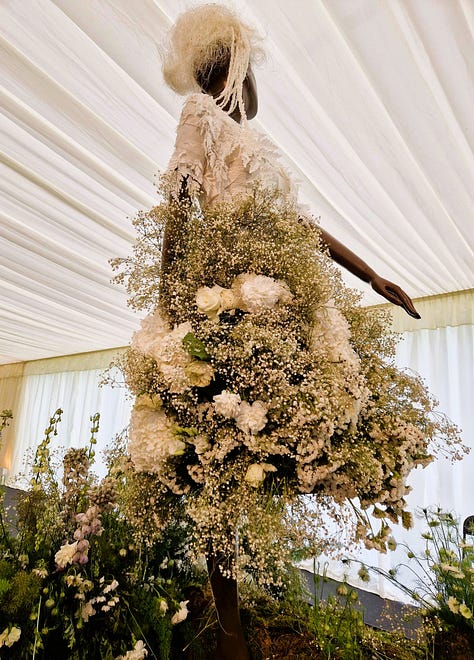


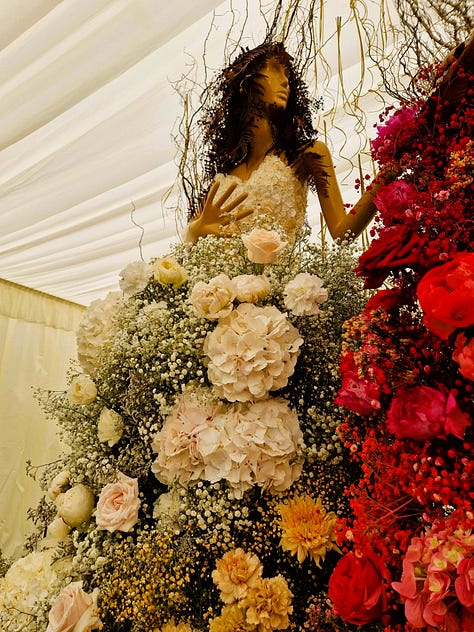
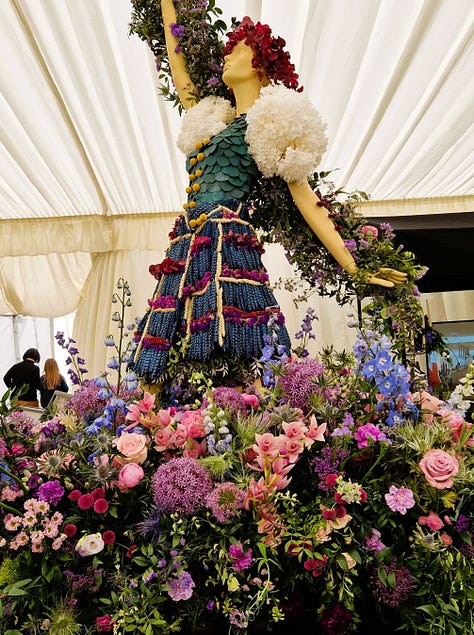
In the JARDIN area, I found Karen Marshall, dressed in an elegant flowing summer dress of green and white. She was readying the setup for the last talk of the day – a glimpse into the 100+ previous shows put on in 29 cities across Canada, the United States, England, Scotland and Australia by Fleurs de Villes, since the project was founded in 2016 – but she generously sat down with me for an informal interview.*
“What drew you at first to working with flowers?” I asked first. “Because I imagine this project couldn’t have been an overnight whim.”
It wasn’t a whim, Karen explained – “but it was a lightning-bolt moment. I’m not a florist, first of all. I had a long career in magazine publishing – I worked for Vanity Fair magazine and Condé Nast and a load of Canadian magazines – and I really understand audiences and content, and what great content can do by way of connecting people. I was fortunate enough in particular to work for a Canadian women’s magazine called Chatelaine, which was the largest women’s magazine in Canada – it had been around for over 100 years – and one in every three Canadian women read it. It was a really interesting magazine, because people were connected through it, and it was very powerful.
“I was working a lot with shopping malls and destinations as a part of a marketing initiative that I was doing at a design agency I was working with, and I kept seeing flowers on Instagram and Facebook, and I kept thinking about flowers, but I couldn’t find a place to go and see flowers. You could go to weddings, corporate events – private events, you know – but you couldn’t actually go and see flowers outside of that. You go to a florist’s shop, it’s very transactional, because they’re businesses; the business of flowers is what keeps them afloat, weddings and funerals and mother’s day and, you know, graduations and births and celebrations.”
An excellent point, I remember thinking, as I cast my mind back to all the places prior to this where I had seen displays of floral art. The first examples that sprang to mind were the arrangements I had seen at funerals: flower-studded letters spelling out the names and titles of loved ones; sprays arranged to adorn caskets. There – and at weddings – floral art is pivotal. Their absence is felt. (I know, because my parents were married in a church during Lent when flowers weren’t allowed inside, and my mum has often remarked on the strangeness of that.) But you don’t attend weddings and funerals for the flowers themselves. When pressed to it, I couldn’t actually think of a single place I had gone previously for the sole sake of seeing arranged flowers.
“And also recognising that florists were artists, I really wanted to search for that,” Karen continued. “I love history and design and art, fashion and culture, all of those things. And so I was looking for that. I went to the Chelsea Flower Show, which is wonderful, but it’s actually a garden show. It’s show gardens. And I went looking for the floristry, and I saw some of the floristry in the back, and I thought, okay, it’s nice, but imagine what we could do if we just celebrated floristry and floral arts. So that’s what we set out to do, myself and my business partner Tina [Barkley]. She was doing some flower markets in Vancouver, and I was working a lot with retailers in fashion, and I said, “I have this crazy idea for a show of floristry. We could do it in the mall, we could incorporate flower markets and we could do all kinds of things together, and I think people would really like it, because it’s different and we’re creating something we want to see as flower-lovers,” and that’s what started it. And the name was very deliberate, as well. In Canada, we’re very aware of Cirque du Soleil. I always say to my mom, “If a clown from Montréal can create a global circus, we can create a global flower circus!””
The name of the project is explained further on the Fleurs de Villes website: “Our name speaks to [our mission] – Fleurs de Villes – flowers of the cities. Connecting with each city we launch in, we work with top local florists, designers, growers and nurseries, to showcase that city’s world-class talent and create stunning displays of art.”

One thing I noticed – as I was walking around – was that some of the flowers had begun to brown at the edges, and wither. The florists responsible for the arrangements, Karen explained, would visit the exhibition every few days to spruce them up, but – working with an organic medium – some modicum of decay is inevitable.
My partner noticed, too. “It kind of speaks to the ephemeral nature of trends and passing fads, with the way that these flowers are not going to last forever,” she said. “They’re not being preserved. And the way that they do kind of wilt a little bit, and have a little bit of decay, kind of adds to the artistry of the piece.”
“That’s exactly it,” Karen agreed. “And actually, the full cycle of flowers, from buds to blooming, all the way through, it’s quite pretty. And it is – it’s a limited-time thing. You will only see this here, for ten days, then it’s gone. And we’ll come back next year, but it’ll be a different theme, and it’ll be different floral artists, and it’ll look completely different. For example, this is our ARTISTE theme, and ARTISTE is all about celebrating art, but our show in Dallas looked completely different to this. We worked with fifteen different art institutions in Dallas, from the Dallas Opera to the Ballet Theatre, to create different storytelling, so that was a completely different experience.”
I found a lot of meaning in what my partner had touched upon, with the ephemerality of flowers representing the ephemerality of trends. Though it isn’t expressly what Fleurs de Villes set out to do, their work offers a fascinating angle through which to view trend cycles in the modern day. With fast fashion in its current state, we’re encouraged by corporations to view clothes as a disposable good; to prioritise quantity over quality, and feel nothing when our rushed garments’ flimsy seams begin to fall apart, rendering them unwearable. Textile waste has a significant impact on the environment, but our desire for novelty (and corporate desire for increase profit margins) takes precedence. This business model devalues the power of slow and thoughtful garment construction, at the cost of our planet, and our understanding of what goes into the clothes we wear.
With this in mind, Fleurs de Villes makes quite a powerful statement about disposability. Consider the amount of work poured into each installation, the planning and forethought and the maintenance, for a show that lasts scarcely longer than a week! But – far from throwaway – the temporary nature of these creations only makes them more special: blink and you’ll miss them. Flowers are not made to last, but their ephemerality reminds us to pause and appreciate the here and now. We would be wise to take this lesson into the fashion sphere, and to treat our clothes with greater reverence.
Karen then shed some light on future plans the Fleurs de Villes team have up their sleeve. “We’re going to the Cheekwood Estate in Nashville, Tennessee in 2025, and we’ll be there telling the stories of that estate. Conversely, we’re going to be in Calgary in two weeks, at the greatest rodeo on earth, the Calgary Stampede, and we’re launching Fleurs de Villes COUNTRY, a fresh floral celebration of country Western musical icons – Shania Twain and all the rest. We also have a show coming up in Eltham Palace in London, and that will be us telling the stories of Eltham Palace. It’s an old Tudor palace, where Henry VIII played as a child, and it was a favourite residence of Edward IV and his wife Elizabeth Woodville. And it sort of became an Art Deco palace in the 1930s, when a very swish couple from London [the Courtauld family] took it over. We’re curating that storytelling aspect of it, telling the stories of the characters in the palace in a different way that no-one’s ever seen before, and we’re using flowers as the medium.”
“I think the storytelling aspect is a really important part of it,” Holly said. “There’s a festival of flowers down in Winchester – I went to that one time, took my camera and spent the whole day there, because they went to Winchester Cathedral, which is the longest medieval cathedral in Europe – just an absolutely stunning building – and they just covered it in floral installations. The whole frontage was just a floral wall. You go inside, they have these giant bowls of flowers, these incredible individual little installations scattered throughout – they even did this really lovely thing down in the crypt, where they made these rivers of flowers with tea lights woven through them, and it was incredible, absolutely stunning – but it didn’t really tell a story. It was beautiful, and they obviously worked incredibly hard to incorporate the setting of the cathedral and work the architecture into the pieces and into the displays, but it wasn’t telling the story of the cathedral or of Winchester or anything like that.”
Karen lit up at Holly’s description of the Cathedral. But she agreed; storytelling is a really important and underutilised aspect of floral art, and its incorporation within Fleurs de Villes is a part of what makes the project so unique.
“That’s what we want to do, is change that perception,” she said. “Anyone can add flowers to anything, and they do – this is a different way of actually seeing it, and learning something. It’s educational. You can convey a lot of messaging into what we are presenting here, and it’s storytelling. It’s interesting, I think. I’ve created something I wanted to see, and I wasn’t seeing it, so I thought, oh, we’ll just do it. And at the same time we’re functional, in allowing this area here that we’re in—” here she gestured around us, to the JARDIN area, with its rows of chairs, a large table at the front where a television screen stood among bouquets and loose piles of flowers — “to be all about demonstrations, and talks. We bring in specific partners, like Napiers, which is the herbalist’s. The idea of being functional is, we’re providing people education in multiple ways, thinking about how we support the local florists, and elevate them as artists. We’re very passionate about that – the elevation of the floral arts, and the celebration of the artist within.”
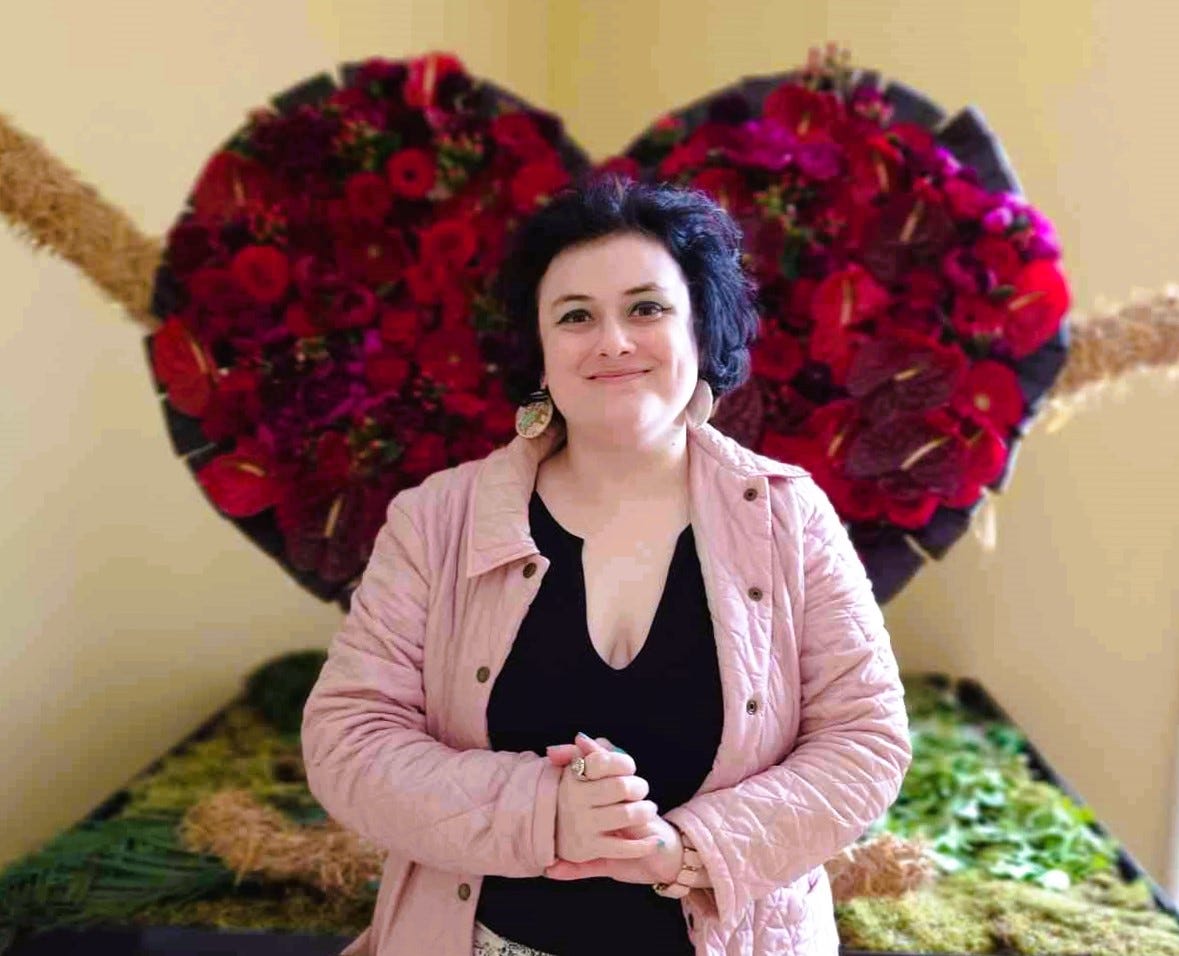
If this essay has piqued your interest and you would like to see more of the beautiful floral art created by Fleurs de Villes, you can find them on Instagram @fleursdevilles. Their upcoming Eltham Palace show will be taking place this July, from the 13th–21st. And if you’re lucky, they may pay a visit to a city near you. It’s a spectacle not to be missed!
Until next time,
Holly
The Doll House
*This interview has been lightly edited for clarity.

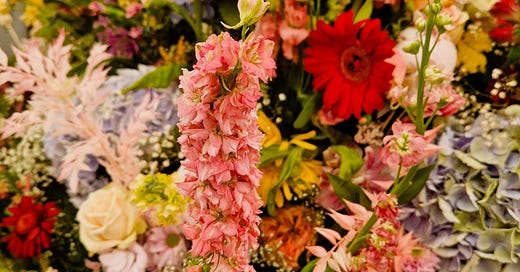


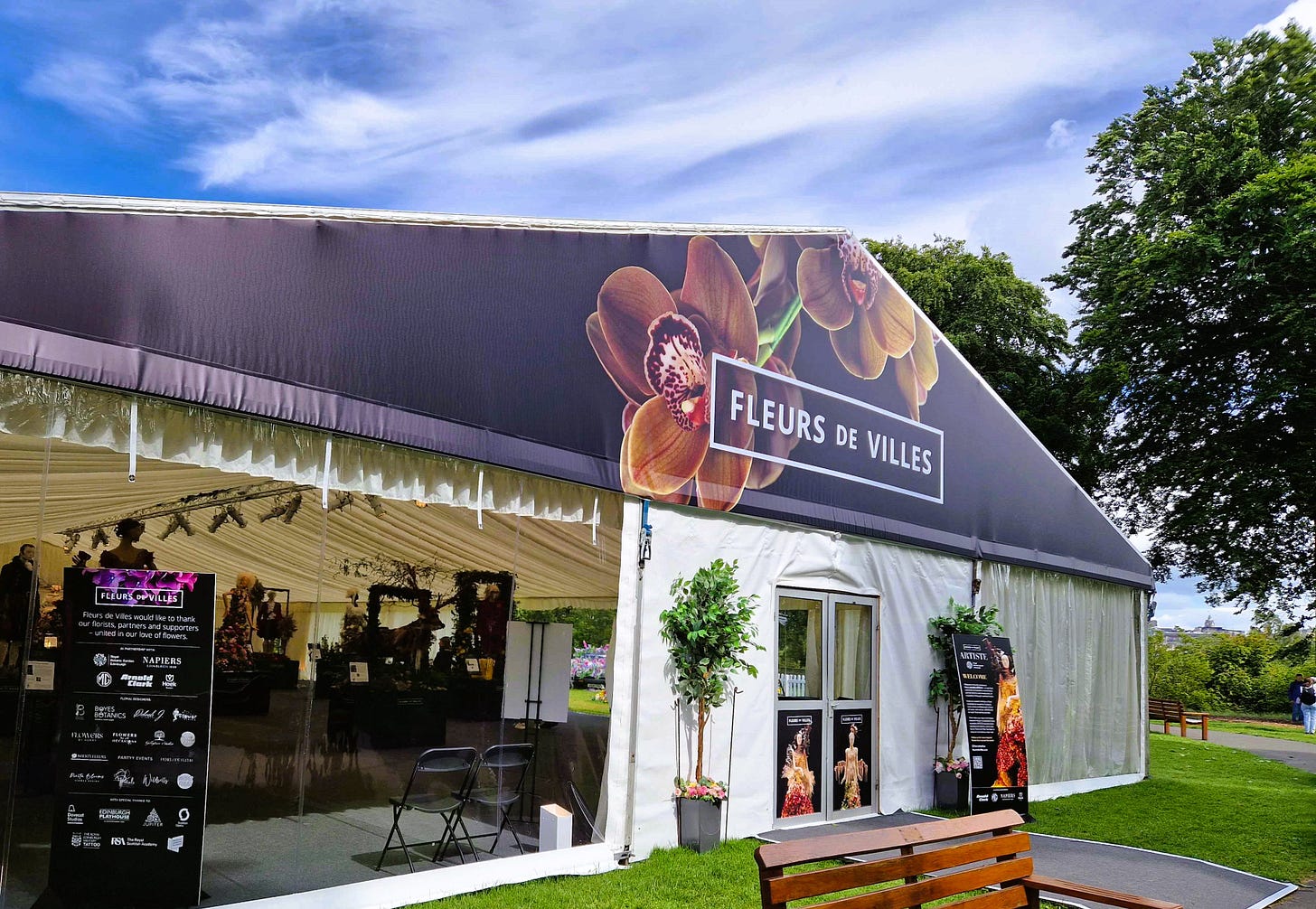

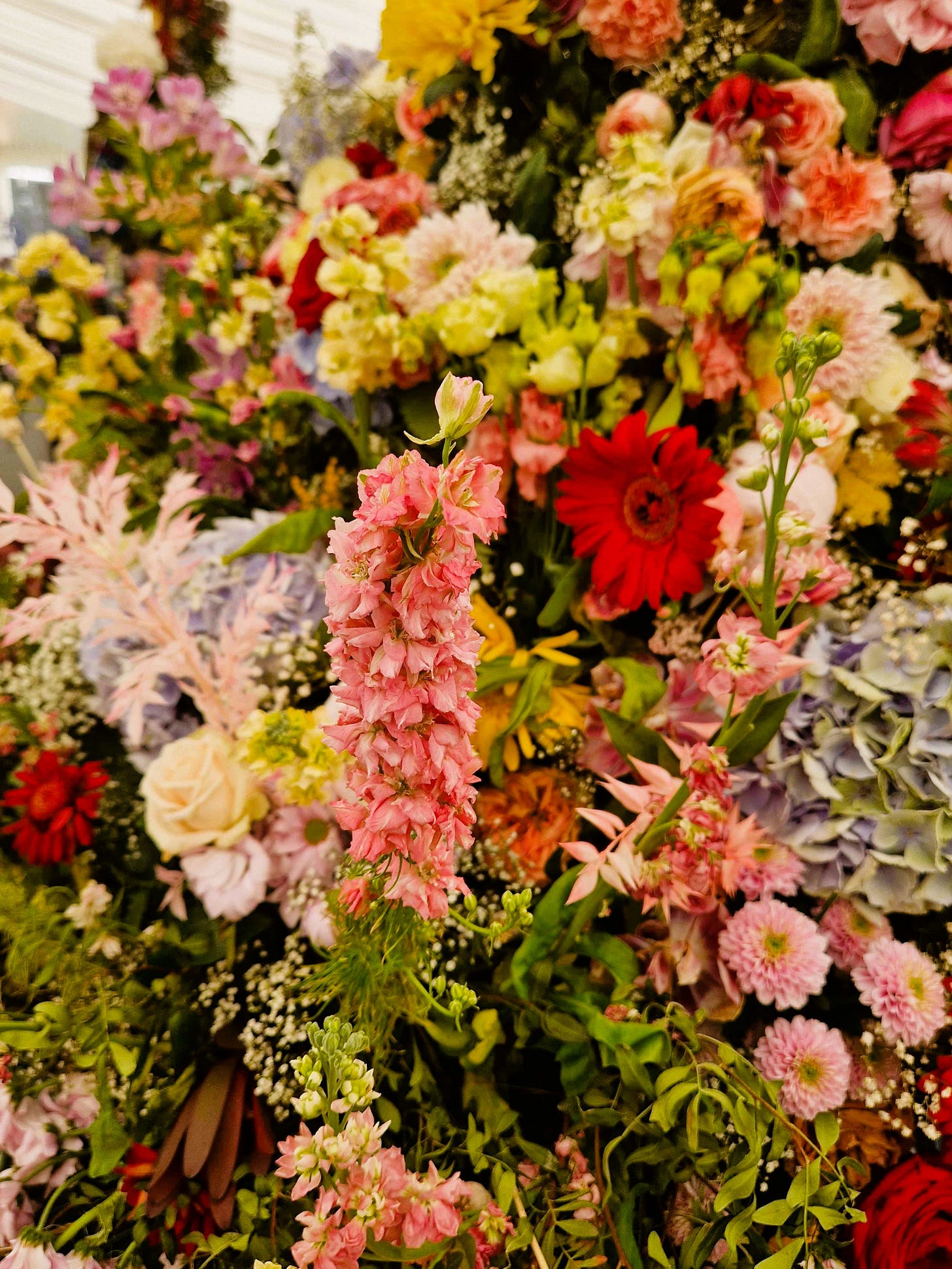

This is all lovely. And Edinburgh is such a lovely city. And your partner's name being Holly made my day. That is all.
Absolutely gorgeous! Thank you for bringing us along with you and Holly to experience the beauty. Also, such a cute picture of you!